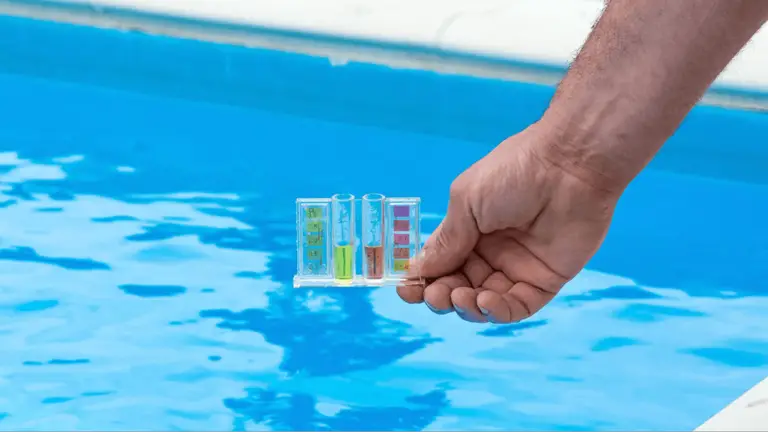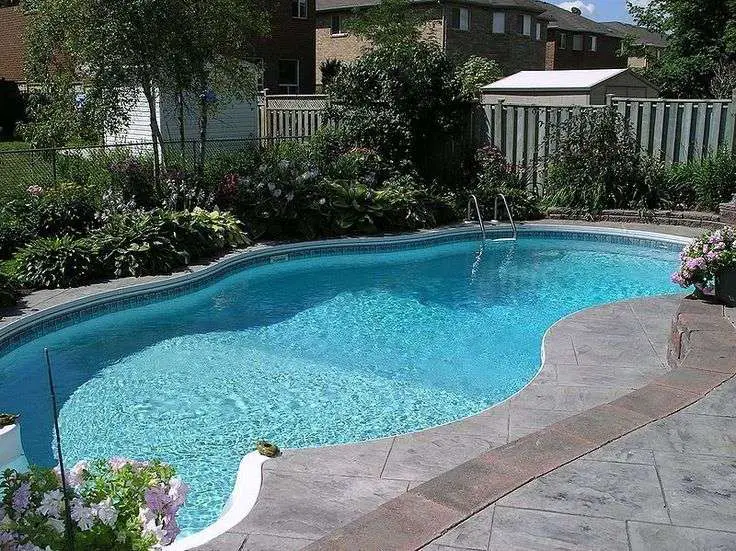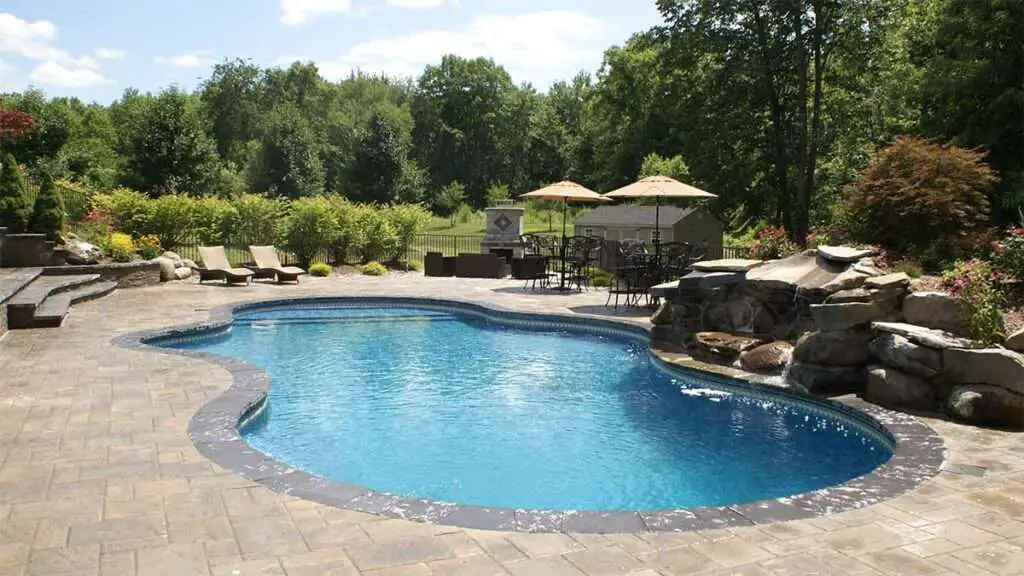How A Saltwater Chlorinator Works
Salt chlorinators are pretty easy for maintenance and last for years as a high-quality addition to your above-ground pool. Even though they cost anywhere from $3,00 to $5,000 or more, their longevity and easy maintenance make them popular for many home pools looking to upgrade to saltwater.
The saltwater chlorinator has two main functions. It allows pool water to flow through over a series of metal grids with low electricity levels flowing through them. The salt in the water reacts with this electricity and comes out the other end as pure chlorine in bubble form.
Without the salt water chlorinator, you cant have a saltwater pool. However, its simple design and intuitive conversion of salt to pure chlorine make it more healthy for the human body to swim in and provides a more enjoyable experience for those swimming in your pool.
Generator Cell And Sensor Maintenance Is An Investment Of Time And Money
Saltwater generator cells require a cleaning every 90 days, or you will end up with calcium buildup. Skipping regular cleanings for six months or more shortens cell life, increases the likelihood that the cell will break, and the pool will eventually become swampy.
The cell in a saltwater generator cell must be replaced every two to three years. The replacements are an investment of about $500 to $800 .
You will also need to have a professional closely monitor and clean the sensor that determines how much salt needs to be added to the water, or you can end up with a serious chemistry imbalance.
Shock Your Pool Once In A While
Once in a while, youll probably find that its necessary to shock your pool with granular chlorine. Its best to add this task to your monthly maintenance routine, but if youre just dead set against adding more chemicals, you can wait until its needed.
There are a few indicators that let you know when its time to shock your saltwater pool. One of them is that youll start to have trouble balancing your chemicals. You might also notice your water is a little cloudier or start to smell the strong scent of chloramines.
Don’t Miss: Above Ground Pools With Decks Prices
How To Maintain A Trouble
Maintaining a trouble-free saltwater swimming pool is not rocket science its all about monitoring chemicals used in the pool regularly and maintenance of chlorine via a regulating chlorine generator.
From my own experience with a saltwater pool for more than five years now, the major problems you will encounter in a saltwater pool are calcium buildups that come in your pool as white flakes, low chlorine levels that cause cloudiness, low salinity, salt chlorinator maintenance, and corrosion issues.
Pool Water Delivery Cost

A 15,000-gallon pool will cost from $80 to $160 using your garden hose or $600 to $1,200 trucked in. While its entirely possible to fill your pool with a garden hose, it will take some time. A water tanker holds about 9,000 lbs. of water, and youll need a tanker and a half of water. It costs more to hire tankers, but it is much faster.
- City Water Having a pool can increase your water bill by about $4 to $20 per month, due to the 2 inches per week loss of water per day due to evaporation. The average price per gallon of water ranges from $0.002/gallon to $0.011/gallon .
- Well Water Well water isnt treated whereas city water is. The metals and minerals can stain your pool wall and possibly turn the water brown. You can filter the water before it goes into the pool with something like a Hayword Bobby filter on the end of your garden hose which filters out the impurities, or treat the water once its in the pool with a metal control treatment or water clarifier.
Don’t Miss: Mandalay Bay Pool Prices
Salt Water Pools Have Softer Water
You might be surprised to learn that salt water pools contain far less salt than seawater. The oceans salt level is 35,000 parts per million , roughly ten times more salt than that water in a salt water pool.
As a result, the water feels quite soft, and you wont notice the salt in a salt water pool the same way you do at the beach. It doesnt even taste saltybut you still shouldnt drink it.
Saltwater Pool Vs Chlorinated Pool
A saltwater pool gets cleaned using a filtering system called a salt chlorine generator. The system uses electricity to turn salt into chlorine, which cleans the pool.
In a chlorinated pool, chlorine tablets or granules are physically added on a regular basis for the same purpose.
In both pool types, its important to still check the pH levels and alkalinity of the pool so it stays sanitized and the chemicals stay balanced.
Dont Miss: How To Keep Bugs Out Of Pool
Read Also: Pool Chlorine Target
How To Balance Chemicals In A Saltwater Pool
In any swimming pool, you must begin with chemically balanced water. To accurately test and adjust important chemicals such as pH, free chlorine, combined chlorine, total chlorine, total alkalinity, cyanuric acid, and bromine, I use the LaMotte ColorQ Pro 11 digital pool water test kit. It takes a very accurate measurement for all the chemicals at once.
What Materials Are Needed To Convert To A Saltwater Pool
As neat as it would be to just add table salt to your water, to convert your pool to saltwater, first you’ll need a few necessary components . You’ll need the following:
You’ll also need to be sure to have proper electricity available to power the system.
Choosing the Right Salt Chlorinator System for Your Pool
The main component of a saltwater pool system is the chlorinator. A salt chlorinator system consists of two major parts: the salt cell and the control board. The salt cell is where the electrolysis takes place that converts the salt in your pool’s water to chlorine. The control board controls how much chlorine is generated.
Which system you choose is largely a matter of preference and budget, as some systems come with considerably more features than others. But what is most important is that you choose a salt system that is rated for your pool’s water volume. The most common ratings are 15,000 gallons, 25,000 gallons, and 40,000 gallons. You’ll just want to choose a system that meets or exceeds your pool’s water volume, and you should be in good shape.
The Importance of a Sacrificial Anode
The anode is added to your plumbing and connects via a wire to whatever piece of metal equipment you’d like to protect. The corrosion is then redirected to an inexpensive zinc anode, which can be easily replaced every few years. This will help keep your pool rust-free.
Don’t Forget the Salt!
BONUS: You know what goes really well with salt? PEPPER!
You May Like: Cyanuric Acid Reducer
Easy Steps For Converting To A Salt Water Pool
The only equipment you need to convert your pool is the salt water chlorine generating system. Purchase a system, such as the AquaRite, consisting of a control box and a salt cell.
The control box is no bigger than a lunch box and it is installed on a wall. The salt cell installs into the existing pool plumbing with standard fittings that come with the product.
Connect the new salt water chlorine generation system to your homes 240V electrical service.
Once the system is connected and salt is dissolved in the pool, the electrical power will charge the salt cell, converting the salt into chlorine. Luxuriously soft water with pure, fresh chlorine is returned to the pool.
For more information, check out our article, How to Convert a Chlorine Pool to a Salt Water Pool.
Salt Water Pool Vs Chlorine Pool Cost
The difference in the cost of a salt water pool vs. a chlorine pool lies mainly in the cost of chlorine and the initial purchase of the salt system. Both pools use chlorine to keep algae and other bacteria away, providing a healthy environment for swimming.
A salt water pool creates chlorine with a chlorine generator from the salt added to the water. The cell which is the part that generates the chlorine will need replacing every 3 6 years at the cost of about $800. You will also need salt a few times per year at an average price of $10 per 40-pound bag.
In comparison, a chlorine pool needs to have chlorine added quite often. How often depends on the size of your pool and the results of your weekly water testing. Its typical to go through 1 2 buckets of chlorine tablets a year at the cost of $100 to $755 in addition to other balancing chemicals.
Recommended Reading: Does An Inground Pool Increase Property Value
Crank Up The Salt Water Generator
Check your pools chemistry again. The ideal levels for your salt water pool are:
- pH: 7.4 7.6
- Chlorine: 1.0 3.0 ppm
- Salt: 3,000 3,500 ppm
Before starting the generator, its a good idea to go ahead and shock your pool with another type of pool shock, like cal-hypo, and then wait for your chlorine to return to its ideal level.
This is especially a good idea if you cant get your pool chemistry to balance, and should help stabilize all the levels.
Once the chlorine has returned to around 1.0 3.0 ppm, you can turn on your salt chlorinator system.
You can choose the amount of chlorine production you want for your pool, but if youve just shocked it and all the levels are in normal range, 50% production is a good starting point.
Salt Water Testing Strips

To check your salt water PPM levels, youll need specialized salt water testing strips. Not that salt water testing isnt included in your regular 7-in-1 testing strips so if youre thinking of converting to a salt water pool, get a bottle of these salt water testing strips when you get your salt water chlorinator. Testing for salt water PPM is also different than testing for chemical levels in your pool.
Regular chemical testing with 7-in-1 test strips require you to swish your strip in the pool water and see how the colors change. To test for salinity, fill the included container up to the required level and then put in the strip and leave for five minutes. The color on the strip should start to fade, and the highest faded point should be your PPM reading. The way this works is that the strip has different resistances for salt concentration, the faded parts of the strip have had their requirements fulfilled and have done their job, while the unfaded sections means that there isnt enough salt in the water to cause them to fade, giving you an approximate reading of the salt level in the water.
P.S. Do not submerge the entire strip into the water! Only submerge the indicated section of the strip to get the proper readings!
Now that we have everything that we need to convert our pool into a salt water pool, its time to install our salt water chlorinator!
Read Also: Aria Swimming Pool
Maintenance Is A Breeze
To an extent, salt water pools maintain themselves. A salt chlorine generator will gently clean the water by breaking the salt into sanitizing agents. This process is ongoing. Your pool is always cleaning itself in the background, and it requires no downtime. You wont need to retool water and chemical levels constantly because the pool equipment is able to manage it on its own.
How To Convert Your Pool To Salt Water
Although salt water pools have been around since the 1970s, their popularity has grown rapidly in recent years. This is due in large part to their reduced cost in upkeep. Theyre also easier on your skin, hair, and eyes, and youve probably heard salt water is healthier than chlorine, too.
Maybe youve been thinking about salt water pool conversion to take advantage of all those benefits. But what a hassle that change would be, right? Actually, the conversion process is fairly simple, so if youre thinking of doing it yourself, youre in luck.
Read Also: Aria Pool Cabanas
How To Convert Your Swimming Pool From Chlorine To Salt
Swimming pools are great for the summer. They provide a way to cool off and have fun, but they can also be a pain. The smell of chlorine lingers in your hair and on your skin all day, youre constantly worried about getting sick from the chemicals, and its difficult to keep equipment clean. One solution is switching to saltwater pool systems. Saltwater pools are not only easier on you-theyre better for the environment too!
In the past, pool owners would have been reluctant to try saltwater pools for fear of using chemicals. But now, with easy switching steps and a much easier cleaning method, it is becoming more and more popular! In fact, youll be surprised by how long your chlorine stays in your water as opposed to turning into gas. It wont leave that strong smell behind either-you can breathe easy knowing that your lungs will not get irritated after swimming! For those who experience dry skin and irritation from overexposure to chlorine, this will definitely be a welcome change.
What Are The Benefits Of A Saltwater Pool
Since salt cells create chlorine automatically, saltwater pools require less maintenance than traditional swimming pools.
With saltwater pools, you dont have to stock up on or add chlorine ever again. You will save plenty of money and time that would have gone to adding chlorine to your pool.
You can avoid the risks of handling and storing unsafe chemicals. You will also avoid the potential health risks of prolonged exposure to toxins in heavily chlorinated pools.
And since saltwater is relatively gentle, you wont have to worry about itchy skin, burning eyes, dried out hair, or that strong chlorine smell anymore.
Recommended Reading: How Do I Lower Chlorine Levels In My Pool
Also Check: Does Cyanuric Acid Reducer Work
How Much Salt Does A Chlorine Generator Need
Ideally, your salt level should be between 2,700 and 3,400 ppm. But figuring out what that means in terms of how much to add requires some calculation.
First, you need to figure out the volume of your pool if you dont already know. Then you can figure out how much salt you need to add.
Use this handy calculator to easily calculate both.
What Tools Do I Need To Convert My Pool To Salt Water
Before you start the work on converting your above-ground chlorine pool into a saltwater pool, you need some essential tools.
These tools are necessary for water draining, filling, connecting the saltwater filter device, and creating the perfect salt-to-water ratio include:
- Saltwater control box: This is the device that does the saltwater chlorine magic. The pump in this unit takes water from your filled pool, cleans it, and puts salt and a small amount of chlorine back in for fresh pool water.
- Salt cell
- Drain hose
- 240-volt outlet
Once you have this small list of tools assembled, you can begin work on draining your current chlorine pool and filling up the new saltwater pool.
Remember that a saltwater pool needs a different control box than your old pool. The area where the old control box gets installed may require some retrofitting for the chlorination device installation.
Read Also: Why Do Florida Pools Have Cages
The Cons Of A Salt Water Pool
Salt water pool conversion does come with a few drawbacks. Most homeowners feel that these drawbacks are so mild that they arent enough to change their minds. If youre willing to deal with a bit of a startup costs and some changes to your maintenance plan, its simple enough.
- Startup costs
You May Like: Aria Las Vegas Swimming Pool
Inspect Regularly For Scale

One of the biggest problems with salt chlorine generators is that they tend to produce a lot of scaling . To keep this at a manageable level, check your generator every 2-3 months.
You will occasionally find scaling on the salt cell, but more commonly it forms on the metal plates and goes largely undetected until theres a problem.
When you see it, remove as much as you can with your hand or a gentle brush. if its too hard to remove, you might have to make a muriatic acid solution to clean it with.
To do that, mix about five parts water to one part muriatic acid and pour it directly into the salt cell. Let it foam for 10 minutes or so and then pour the solution into the bucket.
Finally, you can wash out the inside of the cell with a hose and put the cap back on.
Remember that when you handle muriatic acid, you should use extreme caution and wear gloves and goggles. Also, protect your skin from coming in contact with it at all.
Also keep in mind that you should only clean your generator when it needs it, especially when youre having to use an acid wash. This is hard on those parts and can decrease the life of the unit if done too often.
Recommended Reading: How Much Do Swimex Pools Cost
Equipment Needed To Convert A Traditional Chlorine Pool To A Salt Water Pool
A salt water pool requires very little new equipment and its easy to convert a traditional chlorine pool to saltwater swimming pool. In fact, you can make the change from a traditional chlorine pool to a salt water pool in just a day. Here is the equipment youll need:
To find a list of experienced pool professionals in your area, visit Hayward.com/locator and enter your zip code.
Now that you know what youll need, here are 3 easy steps for making the transition to salt chlorination.
